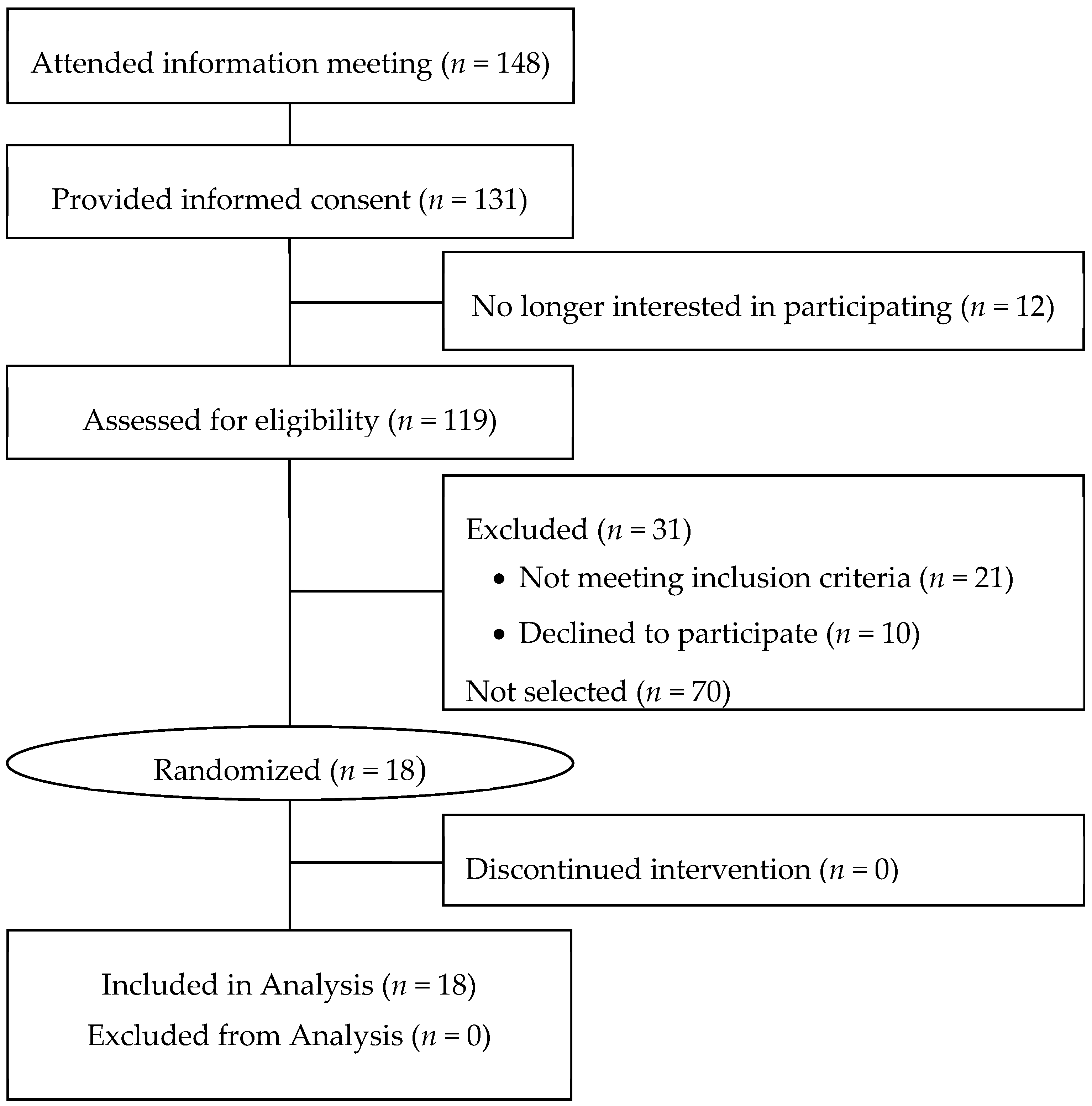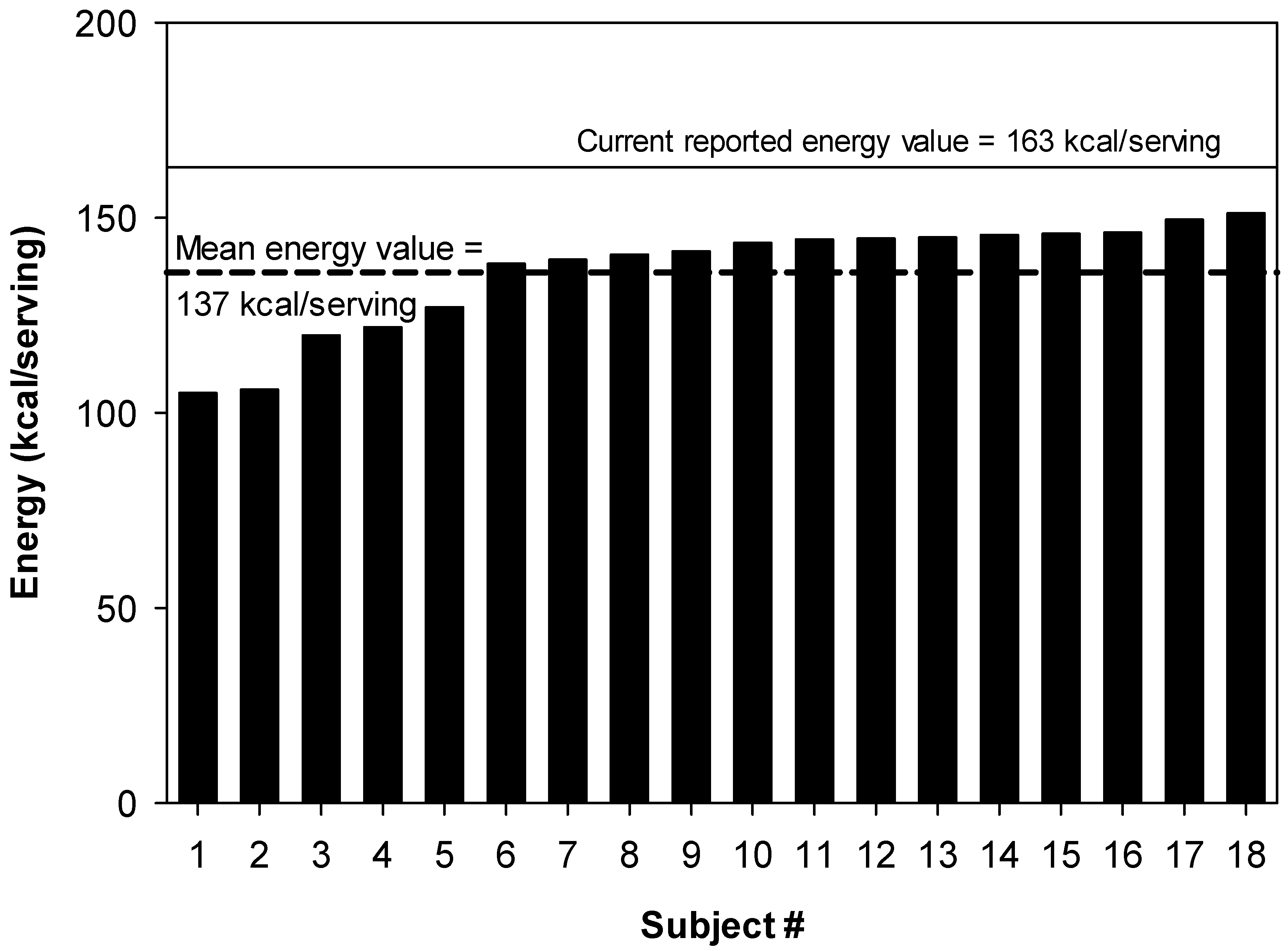Metabolizable Energy from Cashew Nuts is Less than that Predicted by Atwater Factors
Abstract
1. Introduction
2. Materials and Methods
2.1. Study Design
2.2. Diets
2.3. Sample Collection and Analysis
2.4. Data Analyses
3. Results
3.1. Results from Recruitment and Enrollment of Study Subjects
3.2. Composition of Cashew Nuts
3.3. Metabolizable Energy of Cashew Nuts
3.4. Body Weight
3.5. Macronutrient Intake and Absorption
4. Discussion
5. Conclusions
Author Contributions
Funding
Acknowledgments
Conflicts of Interest
References
- Baer, D.J.; Gebauer, S.K.; Novotny, J.A. Measured energy value of pistachios in the human diet. Br. J. Nutr. 2012, 107, 120–125. [Google Scholar] [CrossRef] [PubMed]
- Gebauer, S.K.; Novotny, J.A.; Bornhorst, G.M.; Baer, D.J. Food processing and structure impact the metabolizable energy of almonds. Food Funct. 2016, 7, 4231–4238. [Google Scholar] [CrossRef] [PubMed]
- Novotny, J.A.; Gebauer, S.K.; Baer, D.J. Discrepancy between the Atwater factor predicted and empirically measured energy values of almonds in human diets. Am. J. Clin. Nutr. 2012, 96, 296–301. [Google Scholar] [CrossRef] [PubMed]
- Baer, D.J.; Gebauer, S.K.; Novotny, J.A. Walnuts consumed by healthy adults provide less available energy than predicted by the Atwater factors. J. Nutr. 2016, 146, 9–13. [Google Scholar] [CrossRef] [PubMed]
- Merrill, A.L.; Watt, B.K. Energy Value of Foods: Basis and Derivation; U.S. Department of Agriculture: Washington, DC, USA, 1973.
- Grundy, M.M.; Carriere, F.; Mackie, A.R.; Gray, D.A.; Butterworth, P.J.; Ellis, P.R. The role of plant cell wall encapsulation and porosity in regulating lipolysis during the digestion of almond seeds. Food Funct. 2015. [Google Scholar] [CrossRef] [PubMed]
- Mandalari, G.; Grundy, M.M.; Grassby, T.; Parker, M.L.; Cross, K.L.; Chessa, S.; Bisignano, C.; Barreca, D.; Bellocco, E.; Lagana, G.; et al. The effects of processing and mastication on almond lipid bioaccessibility using novel methods of in vitro digestion modelling and micro-structural analysis. Br. J. Nutr. 2014, 112, 1521–1529. [Google Scholar] [CrossRef] [PubMed]
- Mandalari, G.; Parker, M.L.; Grundy, M.M.; Grassby, T.; Smeriglio, A.; Bisignano, C.; Raciti, R.; Trombetta, D.; Baer, D.J.; Wilde, P.J. Understanding the effect of particle size and processing on almond lipid bioaccessibility through microstructural analysis: From mastication to faecal collection. Nutrients 2018, 10, 213. [Google Scholar] [CrossRef] [PubMed]
- Grassby, T.; Picout, D.R.; Mandalari, G.; Faulks, R.M.; Kendall, C.W.; Rich, G.T.; Wickham, M.S.; Lapsley, K.; Ellis, P.R. Modelling of nutrient bioaccessibility in almond seeds based on the fracture properties of their cell walls. Food Funct. 2014, 5, 3096–3106. [Google Scholar] [CrossRef] [PubMed]
- Bailey, R.L.; Akabas, S.R.; Paxson, E.E.; Thuppal, S.V.; Saklani, S.; Tucker, K.L. Total usual intake of shortfall nutrients varies with poverty among US adults. J. Nutr. Educ. Behav. 2017, 49, 639–646, e633. [Google Scholar] [CrossRef] [PubMed]
- Olza, J.; Aranceta-Bartrina, J.; Gonzalez-Gross, M.; Ortega, R.M.; Serra-Majem, L.; Varela-Moreiras, G.; Gil, A. Reported dietary intake, disparity between the reported consumption and the level needed for adequacy and food sources of calcium, phosphorus, magnesium and vitamin D in the Spanish population: Findings from the ANIBES study. Nutrients 2017, 9, 168. [Google Scholar] [CrossRef] [PubMed]
- Rehm, C.D.; Drewnowski, A. Replacing American snacks with tree nuts increases consumption of key nutrients among US children and adults: Results of an NHANES modeling study. Nutr. J. 2017, 16, 17. [Google Scholar] [CrossRef] [PubMed]
- Baer, D.J.; Novotny, J.A. Consumption of cashew nuts does not influence blood lipids or other markers of cardiovascular disease in humans: A randomized, controlled trial. Am. J. Clin. Nutr. 2018, in press. [Google Scholar]
- Harris, J.A.; Benedict, F.G. A Biometric Study of Human Basal Metabolism. Proc. Natl. Acad. Sci. USA 1918, 4, 370–373. [Google Scholar] [CrossRef] [PubMed]
- Mifflin, M.D.; St Jeor, S.T.; Hill, L.A.; Scott, B.J.; Daugherty, S.A.; Koh, Y.O. A new predictive equation for resting energy expenditure in healthy individuals. Am. J. Clin. Nutr. 1990, 51, 241–247. [Google Scholar] [CrossRef] [PubMed]
- US Department of Agriculture, Agricultural Research Service, Nutrient Data Laboratory. USDA National Nutrient Database for Standard Reference, Legacy; Version Current: April 2018; USDA: Beltsville, MD, USA, 2018.
- Grundy, M.M.; Wilde, P.J.; Butterworth, P.J.; Gray, R.; Ellis, P.R. Impact of cell wall encapsulation of almonds on in vitro duodenal lipolysis. Food Chem. 2015, 185, 405–412. [Google Scholar] [CrossRef] [PubMed]
- Larson, N.; Haynos, A.F.; Roberto, C.A.; Loth, K.A.; Neumark-Sztainer, D. Calorie labels on the restaurant menu: Is the use of weight-control behaviors related to ordering decisions? J. Acad. Nutr. Diet. 2018, 118, 399–408. [Google Scholar] [CrossRef] [PubMed]
- Lee-Kwan, S.H.; Pan, L.; Maynard, L.; Kumar, G.; Park, S. Restaurant menu labeling use among adults—17 States, 2012. Morb. Mortal. Wkly. Rep. 2014, 63, 581–584. [Google Scholar]
- Moshfegh, A.; Goldman, J.; Ahuja, J.; Rhodes, D.; LaComb, R. What We Eat in America, NHANES 2005–2006: Usual Nutrient Intakes from Food and Water Compared to 1997 Dietary Reference Intakes for Vitamin D, Calcium, Phosphorus, and Magnesium; USDA: Beltsville, MD, USA, 2009.



| Characteristic | Mean ± SE |
|---|---|
| Age (year) | 56.9 ± 2.4 |
| Body weight (kg) | 83.1 ± 3.8 |
| BMI (kg/m2) | 28.4 ± 1.1 |
| Waist circumference (cm) | 100.9 ± 2.7 |
| Total cholesterol, fasting (mg/dL) | 205.2 ± 5.8 |
| Triglycerides, fasting (mg/dL) | 114.6 ± 14.0 |
| Glucose, fasting (mg/dL) | 96.3 ± 2.0 |
| Systolic blood pressure (mm Hg) | 119.6 ± 3.9 |
| Diastolic blood pressure (mm Hg) | 72.6 ± 2.1 |
| Nutrient | Mean ± SE |
|---|---|
| Macronutrients | |
| Fat (en%) | 29.8 ± 0.01 |
| Carbohydrate (en%) | 21.5 ± 0.02 |
| Protein (en%) | 11.4 ± 0.04 |
| Fatty acids | |
| Saturated fatty acids | 5.98 ± 0.01 |
| Palmitic acid (16:0) (en%) | 2.94 ± 0.01 |
| Stearic acid (18:0) (en%) | 2.72 ± 0.00 |
| Other saturated fatty acids (en%) | 0.32 ± 0.00 |
| Monounsaturated fatty acids | 16.85 ± 0.08 |
| Oleic acid (18:1) (en%) | 16.59 ± 0.08 |
| Other monounsaturated fatty acids (en%) | 0.26 ± 0.00 |
| Polyunsaturated fatty acids | 5.32 ± 0.11 |
| Linoleic acid (18:2) (en%) | 5.28 ± 0.11 |
| Other polyunsaturated fatty acids (en%) | 0.05 ± 0.00 |
| Total Sterols (mg/100 g) | 77.5 ± 5.1 |
| Campesterol (mg/100 g) | 5.0 ± 0.0 |
| Beta-Sitosterol (mg/100 g) | 63.8 ± 5.1 |
| Other sterols and stanols (mg/100 g) | 8.8 ± 0.0 |
| Base Control Diet (Mean, n = 18) | Base + Cashew Diet (Mean, n = 18) | Pooled SEM | p1 | |
|---|---|---|---|---|
| Gross energy (kcal/day) | 2530 | 2610 | 78 | 0.0172 |
| Fat (g/day) | 77.7 | 90.9 | 2.4 | <0.0001 |
| Nitrogen (g/day) | 16.9 | 17.0 | 0.5 | NS |
| Protein (g/day) | 105.8 | 104.9 | 3.3 | NS |
| Carbohydrate (g/day) | 316.5 | 305.6 | 9.8 | 0.0104 |
| Base Control Diet (Mean, n = 18) | Base + Cashew Diet (Mean, n = 18) | Pooled SEM | p1 | |
|---|---|---|---|---|
| Fecal weight (g dry weight/day) | 27.0 | 34.2 | 1.5 | <0.0001 |
| Fecal gross energy (kcal/day) | 129.6 | 186.3 | 8.1 | <0.0001 |
| Fecal fat (g/day) | 1.7 | 3.6 | 0.3 | 0.0003 |
| Fecal nitrogen (g/day) | 1.5 | 1.7 | 0.1 | 0.0051 |
| Fecal protein 2 (g/day) | 9.4 | 10.5 | 0.6 | 0.0051 |
| Fecal carbohydrate 3 (g/day) | 10.7 | 14.2 | 0.6 | <0.0001 |
| Urinary energy (kcal/day) | 118.2 | 115.9 | 5.0 | NS |
| Urinary nitrogen (g/day) | 13.5 | 13.6 | 0.4 | NS |
| Base Control Diet (Mean, n = 18) | Base + Cashew Diet (Mean, n = 18) | Pooled SEM | p1 | |
|---|---|---|---|---|
| Energy (%) | 94.9 | 92.9 | 0.2 | <0.0001 |
| Fat (%) | 97.8 | 96.1 | 0.3 | 0.0009 |
| Protein 2 (%) | 91.2 | 90.1 | 0.5 | 0.0012 |
| Carbohydrate (%) | 94.9 | 92.9 | 0.2 | <0.0001 |
© 2018 by the authors. Licensee MDPI, Basel, Switzerland. This article is an open access article distributed under the terms and conditions of the Creative Commons Attribution (CC BY) license (http://creativecommons.org/licenses/by/4.0/).
Share and Cite
Baer, D.J.; Novotny, J.A. Metabolizable Energy from Cashew Nuts is Less than that Predicted by Atwater Factors. Nutrients 2019, 11, 33. https://doi.org/10.3390/nu11010033
Baer DJ, Novotny JA. Metabolizable Energy from Cashew Nuts is Less than that Predicted by Atwater Factors. Nutrients. 2019; 11(1):33. https://doi.org/10.3390/nu11010033
Chicago/Turabian StyleBaer, David J., and Janet A. Novotny. 2019. "Metabolizable Energy from Cashew Nuts is Less than that Predicted by Atwater Factors" Nutrients 11, no. 1: 33. https://doi.org/10.3390/nu11010033
APA StyleBaer, D. J., & Novotny, J. A. (2019). Metabolizable Energy from Cashew Nuts is Less than that Predicted by Atwater Factors. Nutrients, 11(1), 33. https://doi.org/10.3390/nu11010033




